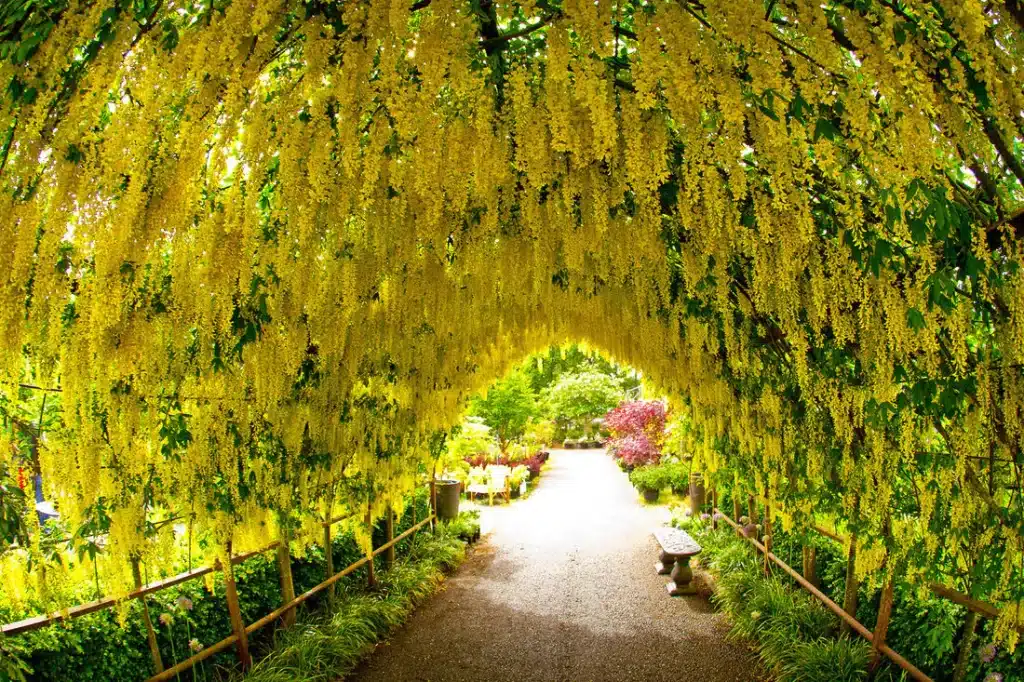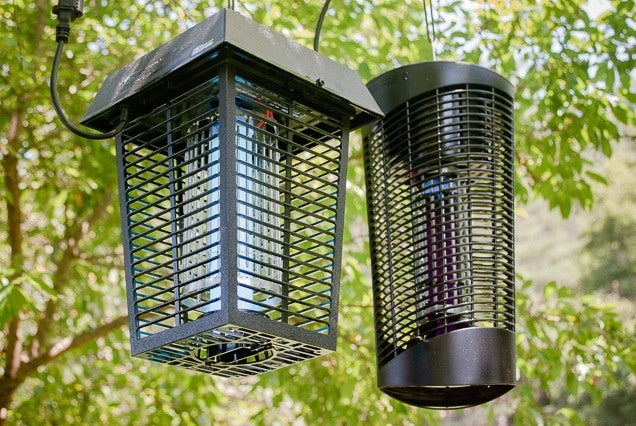This a deciduous tree unlike any other tree that cascades with golden-yellow flowers, resembling chains draped over its frame. This captivating spectacle is the Golden Chain Tree, a beauty that has graced gardens and landscapes for centuries. But beneath its allure lies a hidden danger – all parts of this tree contain toxic alkaloids that can cause severe illness or even death if ingested.
In fact, a study found that ingestion of just a few seeds of the golden chain tree can result in serious clinical effects in children. So, what to do if you’re drawn to this enchanting tree but concerned about its potential risks?
Well, this article will discuss the fascinating world of the golden chain tree, exploring its beauty, its dangers, and how to incorporate it safely into your landscape. We’ll also discuss its toxicity, symptoms of poisoning, and precautions to take when handling it. Additionally, we’ll provide alternative, non-toxic ornamental trees that offer similar beauty without danger.
Table of contents
- What is the Golden Chain Tree?
- What Are The Species Of The Golden Chain Tree?
- Which Is the Best Laburnum Tree?
- What Are The Characteristics Of The Golden Chain Tree?
- What Does Laburnum Smell Like?
- What are the Uses of the Golden Chain Tree?
- Is the Golden Chain Tree Toxic?
- What are the Ingestion Risks?
- What Are The Symptoms Of Golden Chain Tree Poisoning?
- How Long Does It Take For Golden Chain Tree Poisoning To Develop?
- What Are The Precautions to Take When Handling the Golden Chain Tree?
- Are There Any Cultivars Of The Golden Chain Tree That Are Less Poisonous?
- What are the Alternatives to the Golden Chain Tree?
- FAQs
- Conclusion
- References
- Recommendations
What is the Golden Chain Tree?
The golden chain tree, also known as laburnum, is a small deciduous tree with cascading, golden-yellow flowers. It is a member of the pea family (Fabaceae) and is native to the mountainous regions of southeastern Europe.
The golden chain tree is a popular ornamental plant with an abundance of golden-yellow flowers, arranged in drooping clusters that resemble chains as its most striking feature. These flowers bloom profusely in late spring, transforming the tree into a mesmerizing cascade of color. Its botanical name, Laburnum anagyroides, hints at its resemblance to the anagyris plant, known for its medicinal properties.
Read also: Golden Apple Scholars | Apply Now
What Are The Species Of The Golden Chain Tree?
The golden chain tree genus encompasses two distinct species:
- Laburnum anagyroides: This is the most common species of golden chain tree, native to southeastern Europe. It is a small deciduous tree with cascading racemes of golden-yellow flowers that bloom in late spring.

- Laburnum alpinum: This species is also known as the alpine laburnum or the Scotch golden chain tree. It is native to the mountainous regions of southern Europe and is slightly smaller than Laburnum anagyroides. It has similar flowers, but they are slightly paler in color.

Both species of golden chain tree are poisonous, so it is important to take precautions when handling or planting them.
Which Is the Best Laburnum Tree?
Determining the “best” laburnum tree depends on individual preferences and garden conditions. However, among the two main species, Laburnum anagyroides ‘Vossii’ is widely regarded as a superior cultivar due to its exceptional flowering characteristics and overall resilience.
Laburnum anagyroides ‘Vossii’ is a hybrid cultivar that emerged from a cross between Laburnum anagyroides and Laburnum alpinum. It inherits the best traits from both parent species, resulting in a tree that is both beautiful and hardy.
Read also: Golden Key Scholarship for International Students
Distinguishing Characteristics of Laburnum anagyroides ‘Vossii’
- Abundant Flowering: ‘Vossii’ produces profuse clusters of golden-yellow flowers, cascading gracefully from its branches. The flowers are slightly larger and more vibrant than those of the common laburnum, making for a stunning display.
- Prolonged Bloom Time: The flowering period of ‘Vossii’ is slightly longer than that of the common laburnum, extending the visual spectacle for several weeks in late spring.
- Disease Resistance: ‘Vossii’ exhibits greater resistance to fungal diseases, particularly honey fungus, which can be problematic for other laburnum varieties.
- Adaptability: ‘Vossii’ thrives in various soil conditions and can tolerate urban environments, making it a versatile choice for gardens and landscaping.
What Are The Characteristics Of The Golden Chain Tree?
The golden chain tree is a captivating ornamental specimen that adds a touch of elegance and sophistication to gardens, parks, and landscapes. Its cascading golden flowers, delicate leaves, and graceful form create a mesmerizing spectacle. Here are the common features of this tree:
Growth Habit and Form:
The golden chain tree typically reaches heights of 20-30 feet, showcasing a graceful, upright form with slender branches. Its overall growth habit is characterized by a balanced and symmetrical structure, adding elegance to any landscape.
Foliage and Leaves:
Adorned with trifoliate leaves, the golden chain tree exhibits alternate leaf arrangement. These delicate leaves, typically measuring 2-3 centimeters in length, feature smooth margins and a vibrant green hue that complements the tree’s overall beauty.
Blooming Spectacle and Flowers:
The golden chain tree’s crowning glory is undoubtedly its cascading racemes of golden-yellow flowers. These vibrant blooms, reminiscent of chains draped over the tree’s branches, emerge in late spring, transforming the landscape into a mesmerizing spectacle.
Fruit and Seed Pods:
As the golden chain tree’s flowering season wanes, it gives rise to slender, elongated pods that turn brown as they mature. These pods harbor the tree’s seeds, ensuring its continued propagation and perpetuation of its beauty.
Distinguishing Characteristics:
The golden chain tree’s distinctive features set it apart from other ornamental species:
- Cascading Golden Flowers: The tree’s most striking characteristic is its abundance of golden-yellow flowers that cascade gracefully from its branches.
- Delicate Trifoliate Leaves: The tree’s leaves, arranged in threes, add a touch of elegance and complement the vibrant flowers.
- Graceful Upright Form: The golden chain tree’s upright form and slender branches lend a sense of balance and symmetry to any landscape.
What Does Laburnum Smell Like?
The fragrance of laburnum flowers is often described as sweet, delicate, and reminiscent of honey or licorice. It is a pleasant and subtle scent that complements the vibrant yellow color of the flowers. The fragrance is most noticeable during the peak flowering season in late spring, adding an olfactory dimension to the visual spectacle of the tree.
The sweet, honey-like notes in the laburnum fragrance are attributed to compounds such as linalool and methyl anthranilate, which are also found in various other fragrant plants, including lavender, jasmine, and grapes. The licorice-like undertones may arise from the presence of coumarin, a compound also present in tonka beans and vanilla.
While the fragrance of laburnum flowers is generally considered pleasant, some individuals may find it overpowering or even unpleasant. It is important to note that the fragrance can be more intense in close proximity to the flowers, so those with sensitivities may want to maintain a distance to fully appreciate the beauty of the tree without experiencing any adverse effects.
Read also: Golden Financial Services Scholarship Program
What are the Uses of the Golden Chain Tree?
Here’s a closer look at the specific uses of the golden chain tree:
- Garden Focal Point: The golden chain tree serves as a stunning focal point in gardens, drawing attention with its cascading golden flowers and graceful form. Its presence adds a touch of drama and sophistication to garden designs.
- Landscaping Accent: The tree’s elegant silhouette and vibrant blooms make it an ideal accent plant for landscaping projects. It can be used to frame walkways, create borders, or add a splash of color to areas with muted tones.
- Street Tree: The golden chain tree’s adaptability and tolerance for urban conditions make it a suitable choice for planting along streets. Its cascading flowers provide a welcome touch of nature amidst the concrete jungle.
- Pollinator Attractant: The golden chain tree’s fragrant flowers attract a variety of pollinators, including bees, butterflies, and hummingbirds. This enhances the biodiversity of the surrounding ecosystem and contributes to pollination of other plants.
- Specimen Tree: The golden chain tree’s unique beauty and ornamental value make it a prized specimen tree. It is often planted in prominent locations or as a standalone feature in gardens and parks.
- Container Planting: The golden chain tree can also be grown in containers, providing a touch of elegance to patios, balconies, and courtyards. It adds vertical interest and color to these spaces while remaining manageable in size.
- Cut Flowers: The golden chain tree’s delicate flowers can be cut and arranged in vases, adding a touch of nature and elegance to indoor spaces. Their vibrant color and graceful form make them a popular choice for floral arrangements.
Is the Golden Chain Tree Toxic?
Despite its captivating beauty, all parts of the golden chain tree, including the flowers, seeds, bark, and leaves, contain toxic alkaloids, particularly cytosine, that can cause serious illness or death if ingested. These alkaloids are naturally occurring compounds found in various plants, including some legumes and nightshades. Cytisine is structurally similar to nicotine and can exert similar effects on the body.
Symptoms of poisoning can include nausea, vomiting, diarrhea, abdominal cramps, respiratory distress, and seizures. Children and pets are particularly at risk of poisoning due to their smaller size and tendency to put things in their mouths.
What are the Ingestion Risks?
The primary risk associated with the golden chain tree is accidental ingestion of any part of the plant. Ingestion can occur through various means, including:
- Consuming flowers, seeds, leaves, or bark: The golden chain tree’s flowers are particularly attractive to children, who may mistake them for edible treats. Additionally, the seeds and pods of the plant contain high concentrations of toxins.
- Touching the plant and then transferring the toxins to the mouth: Toxin-containing sap from the leaves and bark can be transferred to the hands and subsequently ingested through hand-to-mouth contact.
- Consuming contaminated food or water that has come into contact with the plant: If golden chain tree trimmings are not properly disposed of, they can contaminate food or water sources, leading to poisoning.
Vulnerable Groups
Children and pets are particularly vulnerable to golden chain tree poisoning due to their smaller size and tendency to explore and put things in their mouths. Even small amounts of the plant can be toxic to these groups.
Read also: What Does it Mean To Dream about Apples?
What Are The Symptoms Of Golden Chain Tree Poisoning?
Symptoms of golden chain tree poisoning can vary depending on the amount ingested and the individual’s sensitivity to the toxins. Common symptoms include:
- Gastrointestinal distress: This includes nausea, vomiting, diarrhea, and abdominal cramps. These symptoms are often the first to appear and can be severe.
- Neurological symptoms: These can include headache, dizziness, blurred vision, and muscle weakness. In severe cases, seizures and coma can occur.
- Cardiovascular symptoms: These include rapid heart rate, low blood pressure, and irregular heartbeat. These symptoms can be life-threatening.
- Respiratory symptoms: These include difficulty breathing, shortness of breath, and wheezing. These symptoms can also be life-threatening.
If you suspect that someone has ingested part of the golden chain tree, it is important to seek medical attention immediately. Do not wait for symptoms to appear. Early treatment is essential for the best outcome.
How Long Does It Take For Golden Chain Tree Poisoning To Develop?
Symptoms of golden chain tree poisoning can develop within 30 to 45 minutes of ingesting the toxic parts of the plant. The severity of the symptoms will depend on the amount ingested and the individual’s sensitivity.
In general, the more toxic parts of the plant that are ingested, the more severe the symptoms will be. Children and pets are especially vulnerable to poisoning because they tend to put things in their mouths and are less able to metabolize the toxins.
What Are The Precautions to Take When Handling the Golden Chain Tree?
Here are some precautions to take when handling the golden chain tree:
1. Avoid ingesting any part of the plant.
All parts of the golden chain tree, including the flowers, seeds, bark, and leaves, are poisonous and can cause serious illness or death if ingested. This is especially important for children and pets, who may be more likely to put things in their mouths.
2. Wear gloves when handling the plant.
The sap of the golden chain tree contains toxins that can be absorbed through the skin. Wearing gloves will help to protect your hands from contact with the sap.
3. Wash your hands thoroughly after handling the plant.
Even if you are wearing gloves, it is important to wash your hands thoroughly with soap and water after handling the plant. This will help to remove any toxins that may be on your hands.
4. Do not compost or burn golden chain tree trimmings.
Composting or burning golden chain tree trimmings can release toxins into the air. Instead, dispose of trimmings in a sealed bag in your regular trash.
5. Keep children and pets away from the plant.
Children and pets are particularly vulnerable to poisoning from golden chain tree. Make sure to supervise children and pets when they are around the plant. Teach children about the poisonous nature of the plant and keep pets out of the area where the plant is growing.
6. Seek medical attention immediately if you suspect someone has ingested part of the golden chain tree.
Do not wait for symptoms to appear before seeking medical attention. Early treatment is essential for the best outcome.
Are There Any Cultivars Of The Golden Chain Tree That Are Less Poisonous?
While all parts of the golden chain tree (Laburnum anagyroides) are considered poisonous, there are some cultivars that are thought to have lower concentrations of toxins than the wild species. These include:
- Laburnum anagyroides ‘Autumn Park’: This cultivar is said to have lower levels of alkaloids than the common laburnum. It also produces fewer flowers and seeds, which can further reduce the risk of poisoning.
- Laburnum anagyroides ‘Vossii’: This cultivar is a hybrid between Laburnum anagyroides and Laburnum alpinum. It is thought to have slightly lower levels of toxins than the common laburnum.
- Laburnum anagyroides ‘Pendula’: This cultivar is known for its weeping branches. It is thought to have similar levels of toxins to the common laburnum.
It is important to note that even these cultivars should be handled with care, as they still contain some toxins. If you are concerned about the risk of poisoning, it is best to choose a non-toxic alternative for your garden.
Read also: $ 1,000 Urban Flower Market Scholarship
What are the Alternatives to the Golden Chain Tree?
If you are concerned about the toxicity of the golden chain tree, there are several alternatives that you can consider. These include:
- Japanese magnolia (Magnolia kobus): This small deciduous tree produces fragrant white flowers in the spring. It is a good choice for areas with full sun or partial shade.

- Weeping cherry (Prunus subhirtella ‘Pendula’): This ornamental tree is known for its cascading branches of pink or white flowers. It prefers full sun and well-drained soil.

- Eastern redbud (Cercis canadensis): This small deciduous tree produces showy pink or purple flowers in the early spring. It is a good choice for areas with full sun or partial shade.

- Dogwood (Cornus florida): This small deciduous tree is known for its showy white or pink flowers in the spring. It prefers full sun or partial shade and acidic soil.
- Yoshino cherry (Prunus × yedoensis): This flowering cherry tree is known for its spectacular display of pink flowers in the spring. It prefers full sun and well-drained soil.

These trees offer similar beauty and ornamental value to the golden chain tree, but they are not poisonous and can be safely planted in your yard.
FAQs
Yes, the golden chain tree is considered safe for pets as long as they do not ingest any part of the plant. However, it is always advisable to keep an eye on your pets around the tree to prevent accidental ingestion.
Avoid touching or ingesting any part of the golden chain tree, and wash your hands thoroughly after handling the plant. Wear gloves if necessary.
Seek immediate medical attention if you suspect someone has ingested part of the golden chain tree. Do not induce vomiting, as this could worsen the situation.
Double-bag any trimmings from the golden chain tree and dispose of them in your regular trash. Avoid composting or burning the trimmings, as the toxins can remain active even after decomposition.
There are several non-toxic alternatives to the golden chain tree that offer similar beauty and ornamental value. Examples include the Japanese magnolia (Magnolia kobus), the weeping cherry (Prunus subhirtella ‘Pendula’), and the Eastern redbud (Cercis canadensis).
Every part of the golden chain tree, including the flowers, seeds, bark, and leaves, contains toxic alkaloids. Ingestion of even small amounts can lead to symptoms such as nausea, vomiting, diarrhea, abdominal cramps, and respiratory distress.
Conclusion
The golden chain tree is a captivating ornamental plant, but its poisonous nature demands caution and responsible handling. By understanding the risks and taking appropriate precautions, you can enjoy its beauty without compromising your safety.
References
- business.qld.gov.au – Golden chain tree
- thespruce.com – How to Grow and Care for Golden Chain Tree





